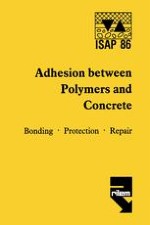1986 | Buch
Über dieses Buch
Preface Adhesion is a phenomenon architects and civil engineers are not very familiar with. In other disciplines knowledge about surface properties and the background of bonding energies is also far from satisfactory; nevertheless there are many important· applications in concrete engineering, where adhesion is necessary for success and durability. These include: - coating and painting - repair of concrete surfaces - bonding of fresh to old concrete - crack injection - glueing of precast elements - glueing of steel to concrete, etc. In 1981 RILEM established the technical committee 52-RAC 'Resin Adherence to Concrete'. The main aims of the committee's work were - to collect research results and practical experiences - to initiate and coordinate research programs - to develop, on a scientific base, test methods for field and for laboratory purposes. One of the results of the committee's work is a state-of-the-art report, which will be presented orally as a General Report at the International Symposium ISAP '86, and will be printed either in the RILEM journal Materials and Structures or separately. Several test recommendations have been elaborated and will be prepared as drafts for the participants ofISAP '86. These are: - direct tensile test - pull-off test - direct shear test - slant shear test - four-point bending test - dynamic loading test - thermal compatibility test (two versions) - injectibility test.
Anzeige
